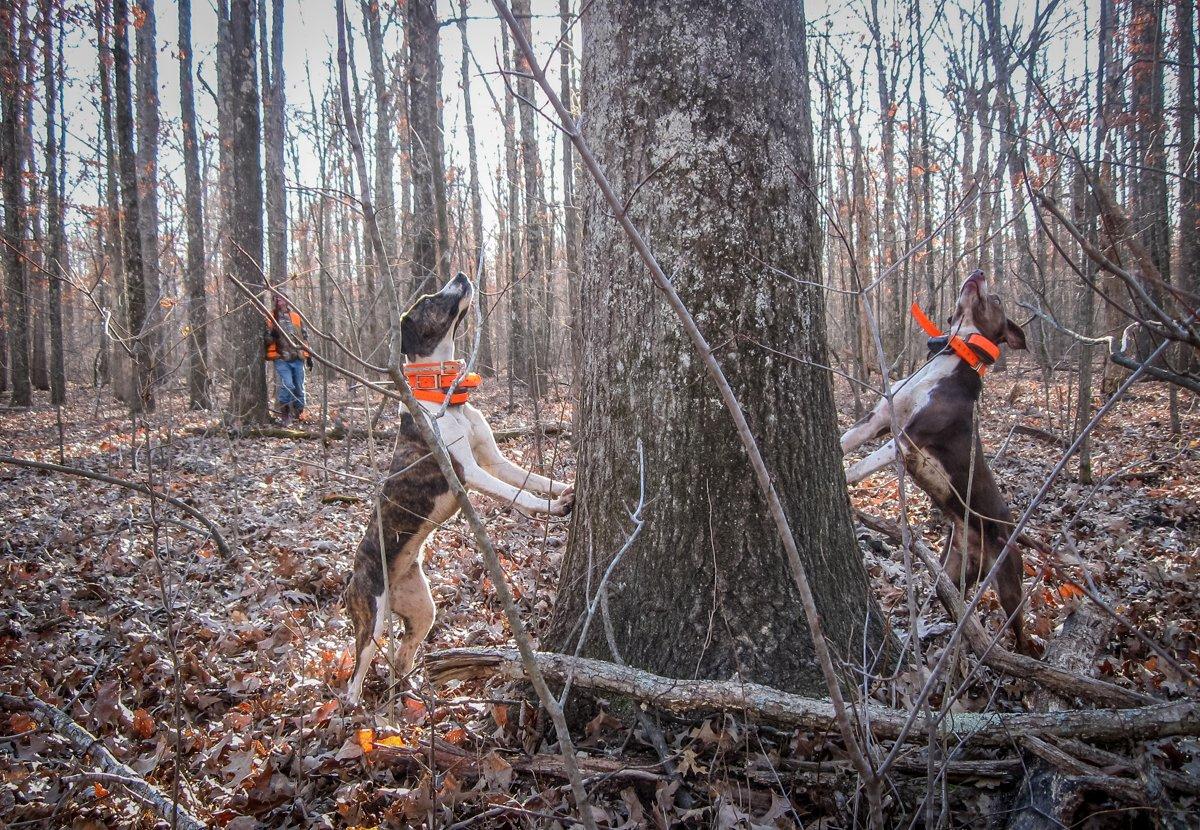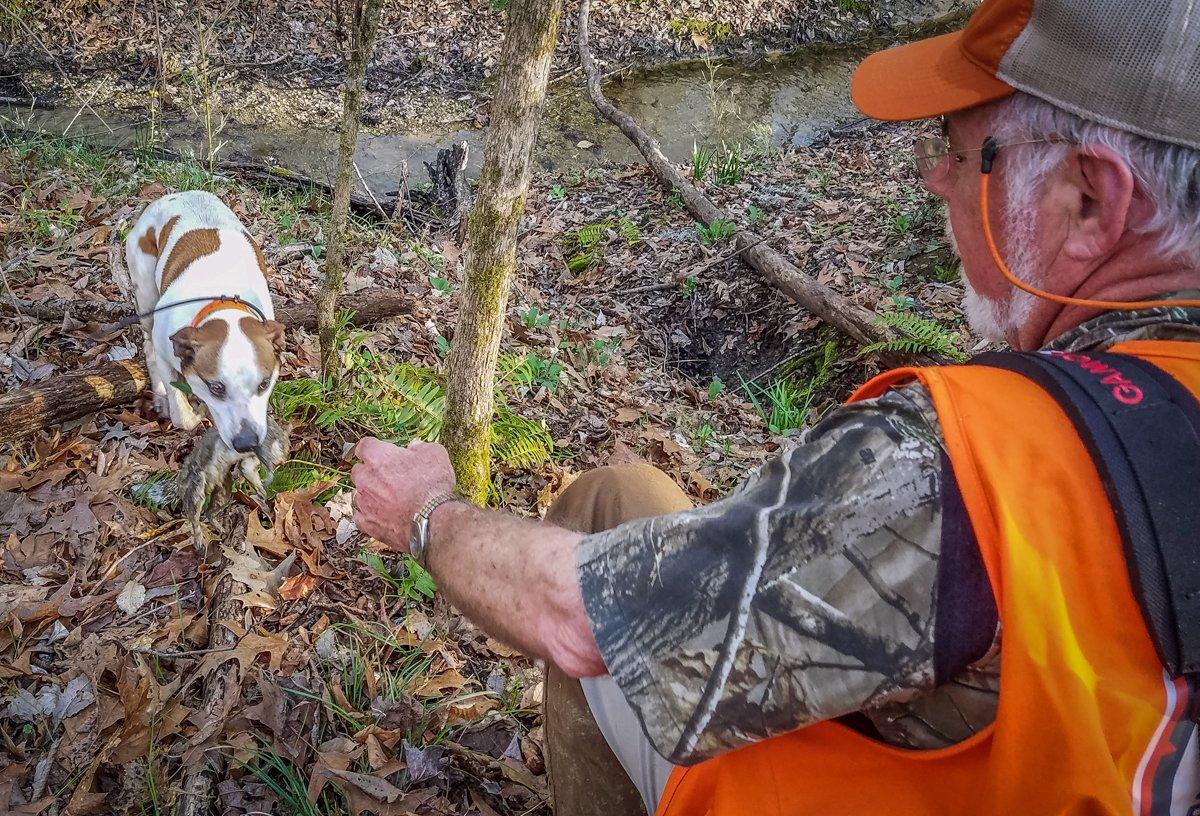Chasing bushytails with a canine may be the best way to introduce anyone, young or old, to hunting
Sometimes talking about squirrel hunting is like bringing up politics at Thanksgiving dinner. You never know what reactions you are going to get. Some people don't understand the idea of hunting for rodents. But in much of the Southeast, the bushytail is the traditional first game that a young hunter will pursue. Another Southeastern tradition is hunting those bushytails with dogs.
Hunting squirrels with dogs? Really? I have been given some funny looks from hunters who are not familiar with squirrel dogs. Why do it? Well, because it is plain old fun and a great way to get the main ingredient for a squirrel, biscuit and gravy dinner.
How it Works
The premise of hunting squirrels with a dog is simple. You follow your canine buddy through the woods as he attempts to locate a squirrel, chase it up a tree, or discover which tree the squirrel is hiding in. Once the dog decides which tree the bushytail is in, he will bark. A good dog will stay on the tree and bark until you arrive and shoot the squirrel.
Now all of this sounds simple, but like many things in hunting (and life), it is not. A lot of folks think a dog treeing a squirrel is easy because they see their dachshund chasing squirrels at the city park. But have you ever sat in your treestand and watched a squirrel skitter through the woods? They will run the length of a downed log, leap on the side of a tree, then bounce off and hit two more trees before they actually climb one. Now imagine your squirrel dog coming along several minutes or an hour later. It takes an experienced dog with a good nose to sort it all out and settle on the right tree.
Once the hunter arrives at the tree, finding the squirrel is not always easy, either. The more eyes the merrier, and good binoculars can help. Sometimes you have to trick the squirrel into moving. Areas with a lot of grapevines call for a vine-pulling contest (which some hunters, especially kids, enjoy as much as the shooting).
Gray squirrels can be especially hard to spot (more so than fox squirrels) and will sometimes timber through the treetops (don't know what "timbering" means? See below). Experienced squirrel dogs watch the squirrel bouncing on the limbs and will follow, usually with a lot of barking. This can make for a lively chase!
If the hunter makes the shot, usually the dog grabs the squirrel for a shake or two, and then you are off in search of the next one. On days when squirrels are active, there can be a lot of action.
If that all sounds like something you'd like to try, then first thing's first: You need a dog.
Talking Squirrel Dogs
If you're going to hang out with squirrel doggers, you need to speak their lingo, and understand words and phrases like:
- Bark Treed: The bark a dog makes when he believes he's located the squirrel in the tree.
- Timbering: Squirrel-dog talk for an escaping squirrel, running through the treetops.
- Toenailed: When a dog has his front feet on the bark of the tree, and the squirrel pinned.
- Has the Meat: The squirrel is confirmed in the tree.
- Range: The distance from the hunter that a dog maintains while looking for a squirrel.
Besides that, know the breeds. Squirrel dogs probably show more variety than any other group of hunting dogs. Some farm dogs, like shepherds and border collie mixes, can make great squirrel dogs. Most of the time, however, if you are shopping for a squirrel dog candidate, you are looking for a cur or a feist.
Don't be confused by the use of cur as a disparaging name for a dog. The cur dog, often known as the mountain cur, is an established breed and has a very loyal following. The feist may share some of the same ancestry with the cur and has been written about in history by no less than William Faulkner and Abe Lincoln. Feist dogs are usually smaller than curs and will generally have less range.
Which camp you land in, cur or feist, does not really matter. What matters is that you pick a dog that you think will fit your own hunting requirements. If your hunting is confined to small woodlots, you may want to go with a feist. If you want your dog to cover a little more ground, think about a mountain cur.
If no breeders are to be found in your area, a quick search on the internet will reveal dozens of squirrel dog kennels, and Squirrel Dog Central is as good a place as any to start. Buying a finished squirrel dog puts you in the game almost immediately, but be warned; fully trained squirrel dogs are not cheap.
Some hunters prefer to skip the puppy stage and choose a young started dog, meaning the kennel owner is saying the dog has been exposed to the woods and squirrels and is displaying the desire to track and tree them. Regardless of age, unless you have acquired a finished squirrel chaser you will need to start a training program.
Patience, patience, and take them to the woods. More than any other canine, squirrel dogs are known for taking care of their own training. Over the years I have heard the owners of several good dogs say, I just took him to the woods and he trained himself. To this I would say yes, and no.
There is no doubt keeping a squirrel dog candidate in the woods as much as possible is important, but it is also necessary to instill some basic obedience training. Teaching your dog to come when called is critical and may save its life someday. Learning to walk on a leash and load in the truck are important as well.
Over the years I have heard the owners of several good dogs say, I just took him to the woods and he trained himself.
Hunting a pup with an experienced dog is often a good way to start out, but most trainers prefer not to rely on this too much. There comes a point where your dog must learn for itself. Experienced squirrel dog men will tell you nothing takes the place of simply taking your dog to the woods and putting in the time and the miles.
A dog can't learn to hunt sitting in the kennel, is a saying I have heard for most of my life. There is no magic bullet to take the place of this. Take your dog to the woods as much as possible. Cur dog icon Allen Franklin clarified this by saying, Take your dog to the woods where there is game. Franklin is from Sarahsville, Ohio, which is well-known in the cur dog world, and has raised and trained many champions.
Slow Down and Enjoy
Don't put the cart before the horse, says Carl Smith of Hilham, Tennessee, who is a household name to those who know squirrel dogs. Too many people concentrate on treeing first; we all want our dogs to tree game, but the dog has got to find the game before he can tree it. Let your young dog learn to hunt and find game before you emphasize treeing too much.
Just go hunting. Young dogs, like young hunters, don't care if it is going to be a perfect day; they just want to go.
The simplicity of it all is a big allure of squirrel dogging. Expensive hunting leases, fancy gear and high-priced tags are not needed. Public ground may have as many squirrels as private. Grab your .22 rifle and maybe a shotgun. Your turkey vest serves as a great squirrel carrier. Load your squirrel dog buddy and go. Bring some kids. They are under no pressure to sit quietly; they can tramp through the woods and make all the noise they want. Everyone will get a kick out of watching the antics of the dogs, and it is a very safe environment for new hunters. There is no need to load a gun until you reach the tree, and once the squirrel is spotted, there is all the time in the world to assist with the shot. It's a great way to spend time in the fall and winter woods.
13 Great Realtree Camo Shotguns
Go here for more Realtree small game hunting. Follow us on Facebook.










